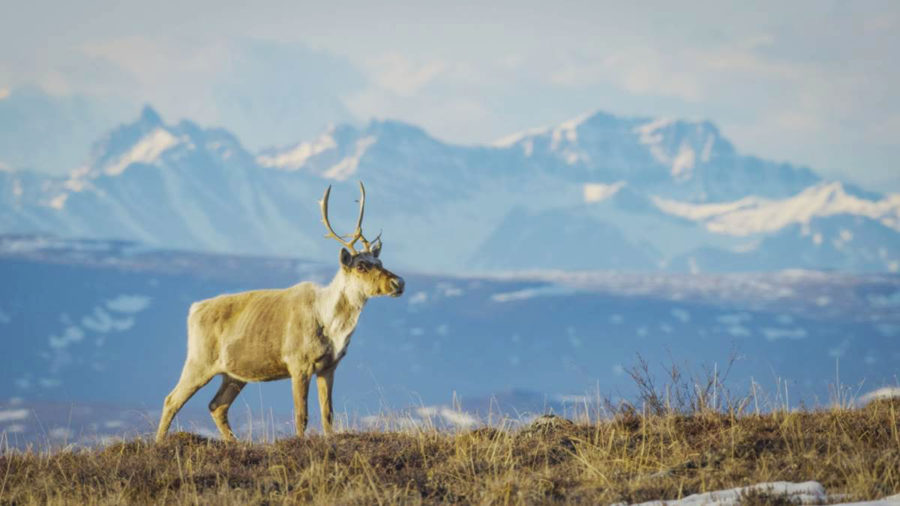National Geographic’s “America the Beautiful” reminds us about the good in America
Courtesy of National Geographic
Caribou living in the Talkeetna Mountains of Alaska are just one of the many wild species documented in National Geographic’s “America the Beautiful.”
December 9, 2022
If you’re anything like me, Thanksgiving break couldn’t have come soon enough. The combination of the typical second-half of the semester anxiety alongside the major midterm election created a stressful few weeks that I honestly needed some relief from. So, over the break, I finally got some time to reflect on both the state of my semester and that of our country. Amidst of all of this, I stumbled across a surprising new series that helped me think about these things through a new lens.
“America the Beautiful” is an original series released this past July on Disney+, the parent company of National Geographic’s commercial ventures. Given its title, this docuseries explores the natural beauty of the United States and the greater North American continent, with a specific focus on the wildlife that inhabits these areas. Narrated by Hollywood star Michael B. Jordan, the six-episode series traverses America’s landscapes and displays how truly diverse our continent is—I mean, where else can you find deserts, swamps, mountain ranges, ice caps, coastal regions and prairies on the same mainland?
Each episode focuses on different geographical regions and includes coinciding titles, such as “Waterland” (referring to the Southeastern U.S.), “Northland,” “Wild West” and “Heartland.” But in all cases, the show produces some of the best landscape cinematography that I have ever seen. The introduction to the show and many of the transitions between storylines utilize spectacular flyover shots of our continent’s numerous lands, ranging from the snow-capped mountains in Alaska to the pristine shores along the Atlantic Ocean, and everything in between. These sequences are also surprisingly intense because they’re so fast-paced that you feel like you’re being pulled into each terrain being shown, which further establishes the particular story or message to the viewer. In addition to this, the show uses fantastic time-lapse technology and 360-degree panoramic views to show incredible shots like New England’s beautiful transition from fall to winter or the grandeur of the mountain region surrounding Denali, the tallest peak in North America.
The wildlife filmmaking is also incredibly well done, owing to the fact that many of those who worked on the series have experience on the BBC and “Disneynature” documentaries. Things like close-up 4K shots of the fur on a white wolf, wide-lens tracking shots of a grizzly bear hunting down a newborn caribou calf and strategically-placed cameras capturing a raccoon family raiding an alligator nest are just some of the amazing visuals captured in this show. But it’s also the way in which the wildlife is filmed that makes each scene compelling, since the viewer follows specific animals in each location. Whether it’s a herd of musk ox braving the arctic conditions in Northern Alaska, a tiny red squirrel in the Grand Teton mountains dealing with much larger thieves raiding his pinecone stash or a pod of dolphins hunting fish so close to the coast of Los Angeles that the Hollywood sign can be seen in the background, each setting feels more like a place than just a landscape. The series also captured rare and never-before-seen footage like the elusive Florida panther, a half-dozen male Alaskan brown bears feeding on the same whale carcass and a mountain lion in the Grand Canyon—I think it’s safe to say that this docuseries ranks up there with some of the best nature filmmaking to date on American wildlife.
Perhaps my favorite part of the “America the Beautiful” series is the final episode, a “Brave New World,” which focuses on the humans working to protect America’s wild animals and natural spaces. The episode emphasizes that everyone can be advocates for change and that any kind of help will make a difference. As long as you’re passionate about what you’re doing and have a vision for improving our natural world, then it is certainly achievable to help combat the climate crisis and enhance conservation efforts. That’s what the people featured in the series finale are doing; whether it be an organization dedicated to rewilding the Northern Great Plains, a father-daughter duo in California cleaning up our oceans and restoring kelp or an indigenous community in Alaska fighting to keep sacred spaces free of oil companies. In each case, there are people dedicated to their respective causes who will stop at nothing to help ensure a better future for America’s diverse natural wonders.
I could go on at length about how awe-inspiring this docuseries actually is, but I hope that I’ve inspired you to check it out for yourself. There’s something incredibly magical about how the cinematographers captured America’s wildlife and landscapes; I think anyone can find beauty in it. But most importantly, I think the show offers us a reminder that no matter how divided we are or how bad things may get, there is a magnificence to this land that we can all appreciate as being truly American.


